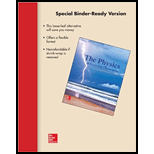
(a)
The magnitude of magnetic force on the ball.
(a)
Answer to Problem 2SP
Magnetic force on the ball is
Explanation of Solution
Given Info The charge of metal ball is
Write the equation for Lorentz magnetic force acting on ball moves in direction perpendicular to magnetic field.
Here,
Substitute
Conclusion:
Therefore, the force is
(b)
The direction of magnetic force on the ball.
(b)
Answer to Problem 2SP
Magnetic force upwards.
Explanation of Solution
Direction of magnetic force on ball is given by the right hand thumb rule. The rule says that if the index finger denotes the direction of motion of ball, middle finger represents the direction of magnetic field; right hand thumb represents the direction of magnetic force.
In the figure, the magnetic field acts into the page and is perpendicular to the page. The ball moves perpendicular to the magnetic field to the right. Pointing the index finger of the right hand in the direction of motion of ball and middle finger into the page makes the thumb to point upward.
Conclusion:
Therefore, the Magnetic force acts upwards.
(c)
Whether the force on ball will change the magnitude of the velocity of ball.
(c)
Answer to Problem 2SP
The force on ball will not change the magnitude of the velocity of ball, it can only change the direction of velocity.
Explanation of Solution
Velocity is a vector quantity having both magnitude and direction. The magnetic force acting on the ball is perpendicular to the direction of motion of the ball. This makes the ball to have a circular motion. The direction of velocity in circular motion is changing at every instant since the direction is along the tangent at a particular instant.
The magnitude of the direction of the velocity is given as the ratio of the magnetic force to the product of the charge of the ball and the magnitude of the magnetic field. All the quantities in the ratio are constant so that the ratio will be constant. Since the ratio is a constant the magnitude of the velocity also will be a constant.
Conclusion:
Therefore, the force on ball will not change the magnitude of the velocity of ball.
(d)
The magnitude of the acceleration of the charged ball.
(d)
Answer to Problem 2SP
The magnitude of the acceleration of the charged ball is
Explanation of Solution
Given Info The mass of the ball is
Write the formula to calculate the acceleration of ball.
Here,
Substitute
Conclusion:
Therefore, the acceleration of the charged ball is
(e)
The radius of circular path through which ball moves under the influence of magnetic field.
(e)
Answer to Problem 2SP
The radius of circular path is
Explanation of Solution
Given Info The velocity of the ball is
Write the equation for centripetal acceleration.
Here,
Rewrite the above relation for
Substitute
Conclusion:
Therefore, the radius of circular path is.
Want to see more full solutions like this?
Chapter 14 Solutions
Physics of Everyday Phenomena (Looseleaf)
 College PhysicsPhysicsISBN:9781305952300Author:Raymond A. Serway, Chris VuillePublisher:Cengage Learning
College PhysicsPhysicsISBN:9781305952300Author:Raymond A. Serway, Chris VuillePublisher:Cengage Learning University Physics (14th Edition)PhysicsISBN:9780133969290Author:Hugh D. Young, Roger A. FreedmanPublisher:PEARSON
University Physics (14th Edition)PhysicsISBN:9780133969290Author:Hugh D. Young, Roger A. FreedmanPublisher:PEARSON Introduction To Quantum MechanicsPhysicsISBN:9781107189638Author:Griffiths, David J., Schroeter, Darrell F.Publisher:Cambridge University Press
Introduction To Quantum MechanicsPhysicsISBN:9781107189638Author:Griffiths, David J., Schroeter, Darrell F.Publisher:Cambridge University Press Physics for Scientists and EngineersPhysicsISBN:9781337553278Author:Raymond A. Serway, John W. JewettPublisher:Cengage Learning
Physics for Scientists and EngineersPhysicsISBN:9781337553278Author:Raymond A. Serway, John W. JewettPublisher:Cengage Learning Lecture- Tutorials for Introductory AstronomyPhysicsISBN:9780321820464Author:Edward E. Prather, Tim P. Slater, Jeff P. Adams, Gina BrissendenPublisher:Addison-Wesley
Lecture- Tutorials for Introductory AstronomyPhysicsISBN:9780321820464Author:Edward E. Prather, Tim P. Slater, Jeff P. Adams, Gina BrissendenPublisher:Addison-Wesley College Physics: A Strategic Approach (4th Editio...PhysicsISBN:9780134609034Author:Randall D. Knight (Professor Emeritus), Brian Jones, Stuart FieldPublisher:PEARSON
College Physics: A Strategic Approach (4th Editio...PhysicsISBN:9780134609034Author:Randall D. Knight (Professor Emeritus), Brian Jones, Stuart FieldPublisher:PEARSON





